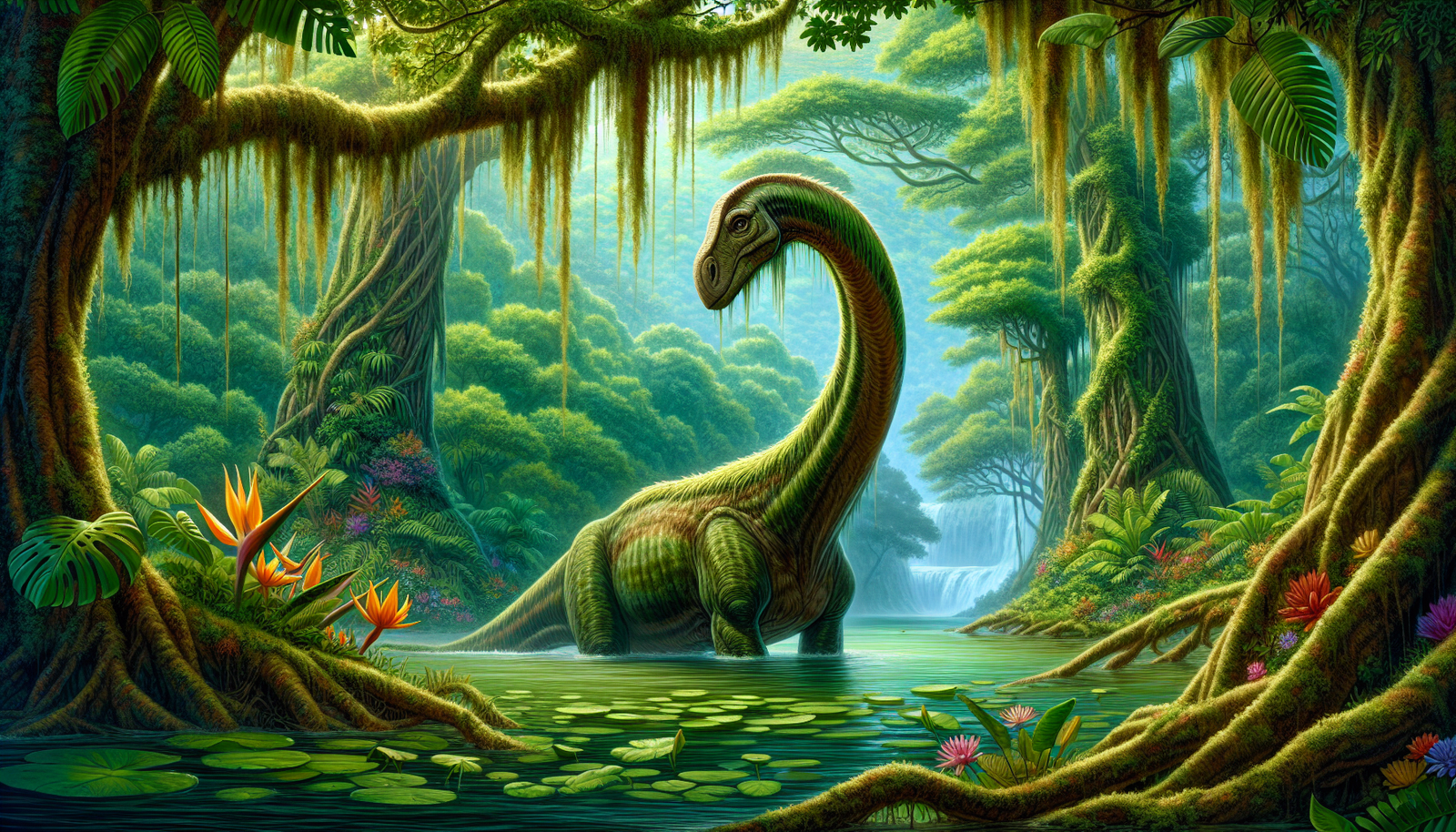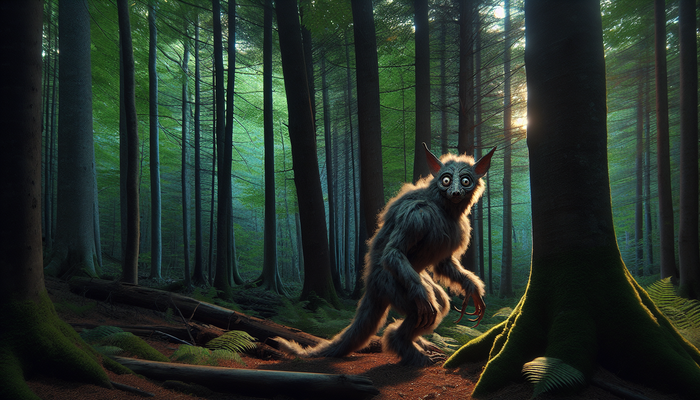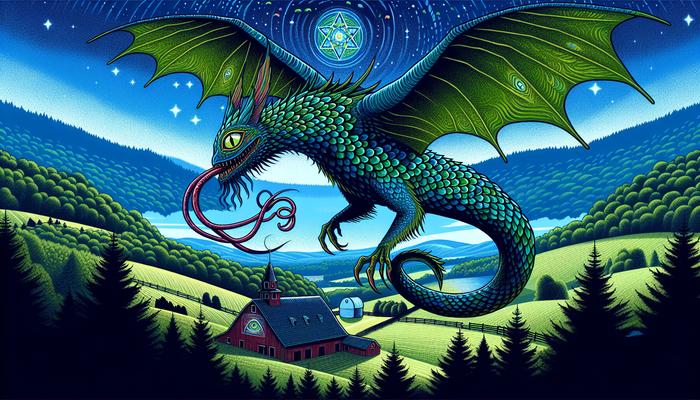Exploring African Cryptids Mythology: Legends of Mysterious Beasts

By Jack Sullivan, Cryptozoologist
The human fascination with the unknown has persisted throughout history, driving us to seek out explanations for the unexplainable and to imagine creatures that lurk just beyond our understanding. This quest for knowledge and wonder finds a rich expression in the realm of cryptids—mysterious beings whose existence is debated but unproven. In African mythology, these elusive creatures play a vital role, embodying the fears, hopes, and cultural values of diverse communities across the continent.
African cryptids are more than mere figments of imagination; they are integral components of a complex tapestry of beliefs that have shaped societies for generations. These beings, whether fearsome or benevolent, serve as powerful symbols of nature's mysteries and the unknown forces that govern the world. They are the subjects of cautionary tales, the guardians of sacred places, and the embodiments of natural phenomena that defy easy explanation.
The Nature of Cryptids in African Mythology
Cryptids in African folklore are as diverse as the continent itself, ranging from giant serpents that control the weather to shape-shifting creatures that prey on the unwary. These beings often blur the line between the natural and supernatural worlds, possessing characteristics that make them both familiar and otherworldly.
Storytelling plays a crucial role in the preservation and transmission of cryptid lore. In many African cultures, oral traditions have been the primary means of passing down knowledge from one generation to the next. These stories serve multiple purposes: they entertain, educate, and instill important cultural values. The tales of cryptids are woven into this rich narrative tradition, becoming vehicles for moral lessons and explanations of natural phenomena.
The intersection of myth and reality is particularly evident in the stories of African cryptids. Many of these creatures are believed to inhabit specific geographical locations, often tied to unique features of the landscape such as deep lakes, dense forests, or remote mountain ranges. This connection to real places lends credibility to the stories and reinforces the belief that these beings could indeed exist just beyond the reach of human observation.
Notable African Cryptids
Mokele-Mbembe: The Living Dinosaur of the Congo
Deep in the heart of the Congo Basin, stories persist of a creature that seems to defy the very laws of nature and time. Mokele-Mbembe, whose name translates to "one who stops the flow of rivers," is described as a massive, sauropod-like animal that inhabits the swamps and rivers of Central Africa. Local tribes speak of a beast with a long neck, a small head, and a large body, reminiscent of the dinosaurs that roamed the Earth millions of years ago.
The legend of Mokele-Mbembe is more than just a tale of a prehistoric survivor; it embodies the mystery and untamed nature of the African wilderness. Eyewitness accounts describe a creature fiercely territorial, known to attack canoes and hippopotamuses that venture too close to its domain. These stories have captured the imagination of cryptozoologists and adventure seekers for decades, sparking numerous expeditions into the dense jungles of the Congo.
Despite the lack of concrete evidence, the persistence of Mokele-Mbembe in local folklore speaks to its cultural significance. For many communities in the region, this creature represents the power and unpredictability of nature, serving as a reminder of the vast unknown that still exists in the world. The search for Mokele-Mbembe continues to this day, with researchers employing modern technology such as drones and thermal imaging in their quest to uncover the truth behind the legend.
Grootslang: The Diamond-Hoarding Elephant-Snake
In the arid landscapes of South Africa, tales are told of a creature that embodies both the majesty of the elephant and the cunning of the serpent. The Grootslang, whose name means "big snake" in Afrikaans, is said to be the result of a divine mistake. According to legend, when the gods first created the world, they made the Grootslang too powerful, combining the strength of an elephant with the intelligence and stealth of a snake. Realizing their error, they split the creature into two separate beings, but one original Grootslang escaped and continues to haunt the deep caves of the Richtersveld.
The Grootslang is not merely a fearsome predator; it is also a guardian of immense treasure. Stories describe caves filled with diamonds and precious gems, zealously guarded by this ancient beast. This aspect of the legend serves as a powerful metaphor for the dangers of greed and the consequences of disturbing the natural order. Those who seek the Grootslang's treasure are said to face certain doom, unless they can outwit the creature or offer it a portion of the gems as tribute.
The tale of the Grootslang reflects the complex relationship between humans and nature in African mythology. It warns against the exploitation of natural resources and the hubris of those who would challenge the established order of the world. At the same time, it speaks to the allure of hidden treasures and the eternal human quest for wealth and power.
Inkanyamba: The Storm-Bringer of Howick Falls
In the mists surrounding Howick Falls in South Africa, the Zulu people tell of a creature that commands the very forces of nature. Inkanyamba, a giant serpent-like being with the head of a horse, is said to dwell in the deep pools at the base of the waterfall. This cryptid is not merely a physical threat; it is believed to have control over storms and weather patterns, capable of unleashing devastating tempests when angered.
The legend of Inkanyamba is deeply intertwined with the natural beauty and power of Howick Falls. During the summer months, when storms are frequent, locals attribute the tumultuous weather to the movements of this great serpent. Some accounts describe Inkanyamba as a shape-shifter, capable of taking on different forms to interact with the human world.
The cultural significance of Inkanyamba extends beyond its role as a weather deity. It serves as a potent symbol of the respect and reverence that many African cultures hold for the natural world. The creature's ability to influence the weather highlights the interconnectedness of all natural phenomena and the importance of maintaining harmony with the environment.
Mamlambo: The River Goddess with a Dark Side
Along the rivers of South Africa, particularly in the Eastern Cape, stories are told of Mamlambo, a creature that embodies both the life-giving and destructive aspects of water. Often referred to as the "Goddess of Rivers," Mamlambo is a complex figure in African mythology, capable of bestowing great blessings or inflicting terrible curses.
Descriptions of Mamlambo vary widely, reflecting the diverse cultures that share her legend. Some portray her as a beautiful mermaid-like being, while others describe a more monstrous form with the body of a giant snake and the head of a horse. This duality in her appearance mirrors the dual nature of her character—she can bring prosperity and fertility to those who honor her, but she is also known for her deadly appetite for human flesh.
The legend of Mamlambo serves as a powerful reminder of the respect due to natural forces. Rivers are essential for life, providing water for drinking, irrigation, and transportation, but they can also be sources of danger through flooding or drowning. Mamlambo personifies this duality, encouraging communities to maintain a balanced relationship with their environment.
In some versions of the myth, Mamlambo is said to lure men to their deaths, using her beauty to entice them into the water where she devours them. This aspect of the legend may serve as a cautionary tale about the dangers of lust and the importance of resisting temptation. It also reflects the very real dangers of rivers and the need for caution when interacting with these powerful natural features.
Adze: The Shapeshifting Vampire of West Africa
In the folklore of the Ewe people of Ghana and Togo, the Adze stands out as one of the most feared and fascinating cryptids. This vampiric creature is believed to have the ability to shapeshift, taking on the form of a firefly by night to gain entry into homes undetected. Once inside, the Adze returns to its human form to feed on the blood of its victims, with a particular preference for children.
The concept of the Adze reflects deep-seated fears within West African societies about witchcraft and malevolent forces that threaten the most vulnerable members of the community. The creature's ability to transform into something as innocuous as a firefly speaks to the belief that danger can come from unexpected sources and that vigilance is always necessary.
In some traditions, the Adze is not just a solitary predator but is associated with witches and sorcerers who use these beings as familiars or agents to carry out their nefarious deeds. This connection to witchcraft adds another layer of complexity to the Adze legend, tying it to broader beliefs about the supernatural and the potential for humans to wield dark powers.
The Adze myth serves several cultural functions. It acts as a warning to children to be wary of strangers and to stay close to home after dark. For adults, it reinforces the importance of protecting the community and maintaining spiritual defenses against evil. The legend also provides an explanation for sudden illnesses or deaths, particularly those that affect children, in a world where medical knowledge was limited.
Popobawa: The Nocturnal Terror of Zanzibar
Off the coast of Tanzania, on the islands of Zanzibar, lurks one of Africa's most terrifying cryptids: the Popobawa. This shape-shifting demon is said to emerge at night, spreading fear and chaos throughout the community. The name Popobawa comes from the Swahili words for "bat" and "wing," reflecting the creature's most common form—a large, bat-like being with a single eye and a sulfurous odor.
What sets the Popobawa apart from many other cryptids is its relatively recent emergence in folklore. Reports of the creature began in the 1960s on the island of Pemba and have since spread throughout the Zanzibar archipelago. This modern origin has led some researchers to speculate that the Popobawa legend may be a manifestation of social and political anxieties during a time of significant change in the region.
The Popobawa is known for its aggressive and often sexual attacks on victims, particularly men. These assaults are said to occur in the victims' homes, with the creature using its shapeshifting abilities to gain entry. The Popobawa's attacks are not just physical; they also carry a strong psychological component, with victims being warned that if they don't speak about their experience, the creature will return.
This aspect of the legend—the compulsion to share the story—has contributed to the rapid spread of the Popobawa myth throughout the islands and beyond. It also serves a social function, encouraging open communication within communities and providing a shared experience that can unite people in the face of a common threat.
The Popobawa legend has had real-world impacts on the communities of Zanzibar. During periods of heightened Popobawa activity, people have been known to sleep outside in groups, believing that the creature is less likely to attack in public spaces. This behavior demonstrates the power of folklore to influence daily life and social interactions.
Kongamato: The Pterosaur of the African Skies
In the swamps and rivers of Zambia, Angola, and Congo, stories persist of a creature that seems to have flown straight out of prehistory. The Kongamato, whose name means "breaker of boats," is described as a flying reptile with leathery wings, a long beak filled with sharp teeth, and a taste for human flesh. Its description bears a striking resemblance to prehistoric pterosaurs, leading some cryptozoologists to speculate that it could be a surviving member of this long-extinct group.
Eyewitness accounts of the Kongamato often come from fishermen and travelers who claim to have been attacked while navigating the waterways of Central Africa. These stories describe a large, reddish creature swooping down from the sky with incredible speed and ferocity, capsizing boats and carrying off unfortunate victims.
The legend of the Kongamato serves multiple purposes within the cultures that tell its tale. On a practical level, it warns of the dangers lurking in the wild, encouraging caution and respect for the natural world. The creature's ability to strike from above, seemingly out of nowhere, reflects the unpredictable and sometimes hostile nature of the environment.
From a cultural perspective, the Kongamato represents the persistence of the past in the present. In a rapidly changing world, the idea that a prehistoric creature could still exist in the remote corners of Africa speaks to a desire to maintain a connection with the ancient and the mysterious. It also challenges the notion that humans have full knowledge and control over their environment, reminding us that there may still be wonders—and terrors—waiting to be discovered.
The search for evidence of the Kongamato has drawn researchers and adventurers to the region for decades. While no conclusive proof has been found, the creature continues to capture the imagination of both locals and visitors. Some researchers have suggested that sightings of the Kongamato might be misidentifications of large bats or other known flying animals, but the persistence of the legend speaks to its power in the cultural imagination.
Nandi Bear: The Night Stalker of East Africa
In the highlands of western Kenya, tales are told of a creature that combines the worst features of several predators into one terrifying package. The Nandi Bear, named after the Nandi people who first described it, is said to be a large, bear-like animal with a sloping back, powerful claws, and a taste for human brains. Despite its name, the creature is not believed to be a true bear, as there are no native bear species in Africa.
Descriptions of the Nandi Bear vary, but most accounts agree on its fearsome nature and nocturnal habits. It is said to be incredibly strong, capable of killing cattle and dragging them into the forest with ease. Some stories claim that the Nandi Bear has a particular fondness for the human brain, leading to gruesome tales of victims found with their skulls split open.
The legend of the Nandi Bear serves several functions within East African cultures. It acts as a powerful deterrent, keeping people—especially children—from wandering into the forest alone at night. The creature's alleged preference for human brains may be a metaphorical warning against the dangers of overthinking or venturing too far into the unknown.
From a cryptozoological perspective, the Nandi Bear presents an intriguing mystery. Some researchers have speculated that it could be a surviving population of short-faced hyenas, prehistoric predators that went extinct thousands of years ago. Others suggest it might be a misidentified known animal, such as a large hyena or a giant forest hog. The lack of concrete evidence has not diminished the Nandi Bear's place in local folklore, where it continues to be one of the most feared cryptids in East Africa.
The persistence of the Nandi Bear legend in the face of modernization and increased scientific knowledge about African wildlife speaks to the power of traditional beliefs and the human need for mystery in the natural world. It also highlights the complex relationship between humans and predators in regions where large carnivores still pose a real threat to human life and livelihood.
Tokoloshe: The Mischievous Spirit of Southern Africa
Among the Zulu, Xhosa, and other southern African cultures, few creatures inspire as much fear and fascination as the Tokoloshe. This diminutive, goblin-like being is said to be a powerful instrument of witchcraft, capable of causing illness, misfortune, and even death. The Tokoloshe is typically described as a small, hairy humanoid with an oversized head and a single buttock, possessing the ability to become invisible by swallowing a pebble.
The origins of the Tokoloshe are deeply rooted in traditional African spiritual beliefs. According to some accounts, these creatures are created by witches or shamans for malevolent purposes. They are said to be particularly fond of causing mischief and harm to sleeping individuals, which has led to the widespread practice of raising beds on bricks to keep them out of the Tokoloshe's reach.
The Tokoloshe legend serves multiple functions within southern African societies. On a practical level, it encourages vigilance and caution, particularly at night when the creature is said to be most active. The belief in the Tokoloshe's ability to cause illness also provides an explanation for sudden or unexplained health problems, offering a framework for understanding misfortune in a world where medical knowledge was limited.
From a social perspective, the Tokoloshe myth plays a role in maintaining community cohesion and moral behavior. The threat of having a Tokoloshe sent against them might deter individuals from engaging in socially unacceptable behavior or from making enemies within the community. The creature's association with witchcraft also reinforces taboos against the practice of malevolent magic.
In modern times, the legend of the Tokoloshe has evolved and adapted to new contexts. While traditional beliefs persist in many rural areas, urban dwellers often view the Tokoloshe through a more skeptical or humorous lens. Nevertheless, the creature remains a powerful symbol in South African popular culture, appearing in literature, art, and even advertising.
The enduring popularity of the Tokoloshe myth demonstrates the flexibility and resilience of traditional African beliefs in the face of modernization. It also highlights the ongoing human need for explanations of the unexplainable and the desire to find meaning in misfortune.
Jengu: The Benevolent Water Spirits of Cameroon
Not all African cryptids are feared or malevolent. The Jengu, water spirits revered by the Sawa people of Cameroon, stand out as benevolent entities that bring blessings and protection to those who honor them. Often described as beautiful, mermaid-like creatures with long flowing hair and glistening skin, the Jengu are believed to inhabit rivers, lakes, and the sea.
In Sawa mythology, the Jengu play a crucial role as intermediaries between the human world and the spirit realm. They are associated with healing, fertility, and prosperity, and are often called upon in times of need. Fishermen seek their blessing for bountiful catches, while women may appeal to them for help with conception and safe childbirth.
The cultural significance of the Jengu extends beyond their role as spiritual helpers. They are seen as guardians of water resources, encouraging responsible use and conservation of these vital ecosystems. This aspect of their mythology reflects the deep connection between African cultures and the natural environment, emphasizing the importance of living in harmony with nature.
Jengu festivals and rituals are important cultural events in Sawa communities. These celebrations often involve offerings, dances, and ceremonies designed to honor the water spirits and seek their continued favor. Such practices not only reinforce traditional beliefs but also serve to strengthen community bonds and cultural identity.
The positive nature of the Jengu legend offers a counterpoint to the more fearsome cryptids of African mythology. It demonstrates the diversity of beliefs across the continent and the complex relationships that African cultures have developed with the natural and spiritual worlds. The Jengu remind us that not all unknown or mysterious entities are to be feared; some may be sources of guidance, protection, and blessing.
In recent years, the legend of the Jengu has gained attention beyond traditional Sawa communities. Environmental activists have sometimes invoked the Jengu in campaigns to protect water resources and marine ecosystems, drawing on the spirits' role as guardians of these environments. This modern application of traditional beliefs highlights the ongoing relevance and adaptability of African mythology in addressing contemporary challenges.
The Cultural Significance of Cryptids
African cryptids are far more than mere curiosities or subjects of scary stories. They play a vital role in the cultural fabric of the communities that tell their tales, serving as vehicles for moral instruction, explanations of natural phenomena, and guardians of traditional values.
Many cryptid legends function as cautionary tales, warning against the dangers of greed, disrespect for nature, or violation of social norms. The Grootslang, with its hoard of diamonds, serves as a powerful metaphor for the perils of unchecked avarice. Similarly, the Adze's preference for attacking children reinforces the importance of protecting the most vulnerable members of society.
These creatures also embody the complex relationship between humans and the natural world in African cultures. The Inkanyamba's control over storms reflects the awesome power of nature and the need for humans to live in harmony with their environment. The Jengu, as guardians of water resources, encourage responsible stewardship of vital ecosystems.
Cryptid lore often serves to explain natural phenomena or historical events. The Kongamato's attacks on boats provide a mythical explanation for the dangers of river travel, while the Nandi Bear's nocturnal habits reinforce taboos against venturing into the forest at night. These stories help communities make sense of their world and pass on important survival knowledge from one generation to the next.
The preservation of cryptid legends is also crucial for maintaining cultural identity, especially in the face of rapid modernization and globalization. These stories connect people to their ancestral lands, traditional beliefs, and shared history. They provide a sense of continuity and belonging that can be particularly important for communities undergoing significant social and economic changes.
In many African societies, cryptids are not relegated to the realm of pure fantasy but are considered part of the lived experience of the community. Belief in these creatures can influence behavior, shape social interactions, and even impact economic activities. The practice of raising beds to avoid Tokoloshe attacks, for instance, demonstrates how cryptid beliefs can have tangible effects on daily life.
The Intersection of Myth and Reality
The study of African cryptids raises fascinating questions about the relationship between folklore and the natural world. While many of these creatures are clearly mythical, some may have roots in misidentified real animals or exaggerated accounts of known species.
Historical accounts and eyewitness testimonies of cryptid encounters often contain details that align with the characteristics of existing animals. The Nandi Bear, for example, shares some similarities with known African predators like hyenas or giant forest hogs. The Kongamato's description as a flying reptile could be based on sightings of large bats or birds of prey.
The field of cryptozoology, which seeks to investigate and potentially discover animals whose existence is unproven, has taken a particular interest in African cryptids. Expeditions have been mounted to search for creatures like Mokele-Mbembe, using modern technology such as camera traps, drones, and environmental DNA sampling. While these efforts have yet to produce conclusive evidence of cryptids' existence, they have contributed to our understanding of the biodiversity of remote African ecosystems.
The persistence of cryptid legends in the age of science and technology speaks to the enduring power of these stories. Even as scientific knowledge expands, there remains a human desire for mystery and wonder in the natural world. Cryptids occupy a unique space in the cultural imagination, bridging the gap between the known and the unknown, the explainable and the mysterious.
In recent years, African cryptids have found new life in popular culture, appearing in literature, film, and digital media. This renewed interest has brought these legends to a global audience, sometimes leading to reinterpretation or commercialization of traditional stories. While this exposure can raise awareness of African cultural heritage, it also raises questions about the authenticity and ownership of indigenous knowledge.
The study of African cryptids offers valuable insights into the ways different cultures perceive and interact with their environment. It highlights the importance of traditional ecological knowledge and the role of storytelling in preserving this wisdom. As we face global challenges like climate change and biodiversity loss, the lessons embedded in cryptid lore about respect for nature and the interconnectedness of all living things may prove more relevant than ever.
Conclusion
African cryptid mythology represents a rich tapestry of beliefs, fears, and hopes that have shaped cultures across the continent for generations. From the terrifying Popobawa to the benevolent Jengu, these creatures embody the complex relationships between humans, nature, and the supernatural world. They serve as powerful symbols of the unknown, cautionary tales against hubris and greed, and reminders of the enduring mystery of the natural world.
As we continue to explore the legends of African cryptids, we gain not only a deeper appreciation for the diversity of African cultures but also insights into our own relationship with the unknown. These stories challenge us to consider the limits of our knowledge and the possibility that there may still be wonders waiting to be discovered in the world around us.
Whether viewed through the lens of folklore, cryptozoology, or cultural anthropology, African cryptids remain a fascinating subject of study. They remind us of the power of storytelling to shape our understanding of the world and our place in it. As long as there are unexplored corners of the Earth and unanswered questions about the natural world, the legends of these mysterious creatures will continue to captivate our imaginations and inspire us to look beyond the boundaries of the known.
From Bigfoot to UFOs: Hangar 1 Publishing Has You Covered!
Explore Untold Stories: Venture into the world of UFOs, cryptids, Bigfoot, and beyond. Every story is a journey into the extraordinary.
Immersive Book Technology: Experience real videos, sights, and sounds within our books. Its not just reading; its an adventure.



























